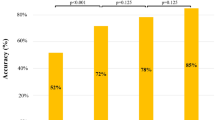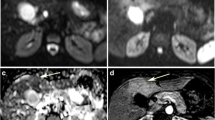Abstract
Background
Recently, the clinical application of diffusion-weighted magnetic resonance imaging (DWI) has been expanding to abdominal organs. However, only a few studies on gallbladder diseases have been published. The aim of this study was to evaluate the usefulness and limitations of high b-value DWI for gallbladder diseases.
Methods
A total of 153 patients (mean age 60 ± 15 years, 78 males) who had undergone DWI for evaluating gallbladder wall thickening or polypoid lesions were included in this study. Of these 153 patients, 36 had gallbladder cancer and 117 had benign gallbladder diseases (67 chronic cholecystitis, 44 adenomyomatosis, four cholesterol polyp, one gallbladder adenoma, and one xanthogranulomatous cholecystitis). We evaluated the positive signal rate with DWI and the apparent diffusion coefficient (ADC) value of each disease.
Results
The positive signal rate with DWI was significantly higher in gallbladder cancer (78 %) than in benign gallbladder diseases (22 %) (p < 0.001). The mean ADC value of gallbladder cancer was (1.83 ± 0.69) × 10−3 mm2/s and that of benign gallbladder diseases was (2.60 ± 0.54) × 10−3 mm2/s (p < 0.001). Benign gallbladder diseases with acute cholecystitis or a history of that had a higher positive signal rate with DWI (p < 0.001) and a lower ADC value (p = 0.018) than those without such conditions.
Conclusion
DWI can contribute to the improvement of the diagnostic capability for gallbladder wall thickening or polypoid lesions by compensating for weaknesses of other modalities by its many advantages, although cases with acute cholecystitis or such history sometimes show false-positive on DWI.





Similar content being viewed by others
References
Kimura K, Fujita N, Noda Y, Kobayashi G, Ito K. Differential diagnosis of large-sized pedunculated polypoid lesions of the gallbladder by endoscopic ultrasonography: a prospective study. J Gastroenterol. 2001;36:619–22.
Kaza RK, Gulati M, Wig JD, Chawla YK. Evaluation of gall bladder carcinoma with dynamic magnetic resonance imaging and magnetic resonance cholangiopancreatography. Australas Radiol. 2006;50:212–7.
Koh T, Taniguchi H, Yamaguchi A, Kunishima S, Yamagishi H. Differential diagnosis of gallbladder cancer using positron emission tomography with fluorine-18-labeled fluorodeoxyglucose (FDG-PET). J Surg Oncol. 2003;84:74–81.
Ching BH, Yeh BM, Westphalen AC, Joe BN, Qayyum A, Coakley FV. CT differentiation of adenomyomatosis and gallbladder cancer. AJR Am J Roentgenol. 2007;189:62–6.
Kim SJ, Lee JM, Lee JY, Kim SH, Han JK, Choi BI, et al. Analysis of enhancement pattern of flat gallbladder wall thickening on MDCT to differentiate gallbladder cancer from cholecystitis. AJR Am J Roentgenol. 2008;191:765–71.
Liang JL, Chen MC, Huang HY, Nq SH, Sheen-Chen SM, Liu PP, et al. Gallbladder carcinoma manifesting as acute cholecystitis: clinical and computed tomographic features. Surgery. 2009;146:861–8.
Jang JY, Kim SW, Lee SE, Hwang DW, Kim EJ, Lee JY, et al. Differential diagnostic and staging accuracies of high resolution ultrasonography, endoscopic ultrasonography, and multidetector computed tomography for gallbladder polypoid lesions and gallbladder cancer. Ann Surg. 2009;250:943–9.
Uchiyama K, Ozawa S, Ueno M, Hayami S, Hirono S, Ina S, et al. Xanthogranulomatous cholecystitis: the use of preoperative CT findings to differentiate it from gallbladder carcinoma. J Hepatobiliary Pancreat Surg. 2009;16:333–8.
Goshima S, Chang S, Wang JH, Kanematsu M, Bae KT, Federle MP. Xanthogranulomatous cholecystitis: diagnostic performance of CT to differentiate from gallbladder cancer. Eur J Radiol. 2010;74:e79–83.
Kimura K, Fujita N, Noda Y, Kobayashi G, Ito K, Horaguchi J, et al. Localized wall thickening of the gallbladder mimicking a neoplasm. Dig Endosc. 2004;16:54–7.
Makino I, Yamaguchi T, Sato N, Yasui T, Kita I. Xanthogranulomatous cholecystitis mimicking gallbladder carcinoma with a false-positive result on fluorodeoxyglucose PET. World J Gastroenterol. 2009;15:3691–3.
Le Bihan D, Breton E, Lallemand D, Grenier P, Cabanis E, Laval-Jeantet M. MR imaging of intravoxel incoherent motions: application to diffusion and perfusion in neurologic disorders. Radiology. 1986;161:401–7.
Yoshikawa T, Kawamitsu H, Mitchell DG, Ohno Y, Ku Y, Seo Y, et al. ADC measurement of abdominal organs and lesions using parallel imaging technique. Am J Gastroenterol. 2006;187:1521–30.
Chan JH, Tsui EY, Luk SH, Fung AS, Yuen MK, Szeto ML, et al. Diffusion-weighted MR imaging of the liver: distinguishing hepatic abscess from cystic or necrotic tumor. Abdom Imaging. 2001;26:161–5.
Taouli B, Tolia AJ, Losada M, Babb JS, Chan ES, Bannan MA, et al. Diffusion-weighted MRI for quantification of liver fibrosis: preliminary experience. AJR Am J Roentgenol. 2007;189:799–806.
Ichikawa T, Erturk SM, Motosugi U, Sou H, Iino H, Araki T, et al. High b-value diffusion-weighted MRI for detecting pancreatic adenocarcinoma: preliminary results. AJR Am J Roentgenol. 2007;188:409–14.
Muhi A, Ichikawa T, Motosugi U, Sano K, Matsuda M, Kitamura T, et al. High b-value diffusion-weighted MR imaging of hepatocellular lesions: estimation of grade of malignancy of hepatocellular carcinoma. J Magn Reson Imaging. 2009;30:1005–11.
Akisik MF, Aisen AM, Sandrasegaran K, Jenninqs SG, Lin C, Sherman S, et al. Assessment of chronic pancreatitis: utility of diffusion-weighted MR imaging with secretin enhancement. Radiology. 2009;250:103–9.
Kamisawa T, Takuma K, Anjiki H, Egawa N, Hata T, Kurata M, et al. Differentiation of autoimmune pancreatitis from pancreatic cancer by diffusion-weighted MRI. Am J Gastroenterol. 2010;105:1870–5.
Miller FH, Hammond N, Siddiqi AJ, Shroff S, Khatri G, Wang Y, et al. Utility of diffusion-weighted MRI in distinguishing benign and malignant hepatic lesions. J Magn Reson Imaging. 2010;32:138–47.
Wang Y, Chen ZE, Nikolaidis P, McCarthy RJ, Merrick L, Sternick LA, et al. Diffusion-weighted magnetic resonance imaging of pancreatic adenocarcinomas: association with histopathology and tumor grade. J Magn Reson Imaging. 2011;33:136–42.
Sugita R, Yamazaki T, Furuta A, Itoh K, Fujita N, Takahashi S. High b-value diffusion-weighted MRI for detecting gallbladder carcinoma: preliminary study and results. Eur Radiol. 2009;19:1794–8.
Irie H, Kamochi N, Nojiri J, Eqashira Y, Sasaquri K, Kudo S. High b-value diffusion-weighted MRI in differentiation between benign and malignant polypoid gallbladder lesions. Acta Radiol. 2011;52:236–40.
Padhani AR, Liu G, Koh DM, Chenevert TL, Thoeny HC, Takahara T, et al. Diffusion-weighted magnetic resonance imaging as a cancer biomarker: consensus and recommendations. Neoplasia. 2009;11:102–25.
Koh DM, Collins DJ. Diffusion-weighted MRI in the body: applications and challenges in oncology. AJR Am J Roentgenol. 2007;188:1622–35.
Cui XY, Chen HW. Role of diffusion-weighted magnetic resonance imaging in the diagnosis of extrahepatic cholangiocarcinoma. World J Gastroenterol. 2010;16:3196–201.
Imai H, Osada S, Sasaki Y, Ikawa A, Takahashi T, Yamaguchi K, et al. Gallbladder adenocarcinoma with extended intramural spread in adenomyomatosis of the gallbladder with pearl necklace sign. Am Surg. 2011;77:E57–8.
Yoshimitsu K, Irie H, Aibe H, Tajima T, Nishie A, Asayama Y, et al. Well-differentiated adenocarcinoma of the gallbladder with intratumoral cystic components due to abundant mucin production: a mimicker of adenomyomatosis. Eur Radiol. 2005;15:229–33.
Conflict of interest
None of the authors have any financial relationships to disclose relevant to this publication.
Author information
Authors and Affiliations
Corresponding author
Rights and permissions
About this article
Cite this article
Ogawa, T., Horaguchi, J., Fujita, N. et al. High b-value diffusion-weighted magnetic resonance imaging for gallbladder lesions: differentiation between benignity and malignancy. J Gastroenterol 47, 1352–1360 (2012). https://doi.org/10.1007/s00535-012-0604-1
Received:
Accepted:
Published:
Issue Date:
DOI: https://doi.org/10.1007/s00535-012-0604-1




